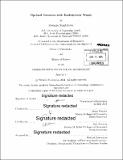| dc.contributor.advisor | James Poterba and Iván Werning. | en_US |
| dc.contributor.author | Stantcheva, Stefanie | en_US |
| dc.contributor.other | Massachusetts Institute of Technology. Department of Economics. | en_US |
| dc.date.accessioned | 2014-09-19T21:41:42Z | |
| dc.date.available | 2014-09-19T21:41:42Z | |
| dc.date.copyright | 2014 | en_US |
| dc.date.issued | 2014 | en_US |
| dc.identifier.uri | http://hdl.handle.net/1721.1/90133 | |
| dc.description | Thesis: Ph. D., Massachusetts Institute of Technology, Department of Economics, 2014. | en_US |
| dc.description | Cataloged from PDF version of thesis. | en_US |
| dc.description | Includes bibliographical references (pages 199-207). | en_US |
| dc.description.abstract | This thesis consists of three chapters on optimal tax theory with endogenous wages. Chapter 1 studies optimal linear and nonlinear income taxation when firms do not know workers' abilities, and competitively screen them through nonlinear compensation contracts, unobservable to the government, in a Miyazaki-Wilson-Spence equilibrium. Adverse selection changes the optimal tax formulas because of the use of work hours as a screening tool, which for higher talent workers results in a "rat race," and for lower talent workers in informational rents and cross-subsidies. If the government has sufficiently strong redistributive goals, welfare is higher when there is adverse selection than when there is not. The model has practical implications for the interpretation, estimation, and use of taxable income elasticities, central to optimal tax design. Chapter 2 derives optimal income tax and human capital policies in a dynamic life cycle model with risky human capital formation through monetary expenses and training time. The government faces asymmetric information regarding the stochastic ability of agents and labor supply. When the wage elasticity with respect to ability is increasing in human capital, the optimal subsidy involves less than full deductibility of human capital expenses on the tax base, and falls with age. The optimal tax treatment of training time also depends on its interactions with contemporaneous and future labor supply. Income contingent loans, and a tax scheme with deferred deductibility of human capital expenses can implement the optimum. Numerical results suggest that full dynamic risk-adjusted deductibility of expenses is close to optimal, and that simple linear age-dependent policies can achieve most of the welfare gain from the second best. Chapter 3 considers dynamic optimal income, education, and bequest taxes in a Barro- Becker dynastic setup. Each generation is subject to idiosyncratic preference and productivity shocks. Parents can transfer resources to their children either through education investments, which improve the child's wage, or through financial bequests. I derive optimal linear tax formulas as functions of estimable sufficient statistics, robust to underlying heterogeneities in preferences. It is in general not optimal to make education expenses fully tax deductible. I also show how to derive equivalent formulas using reform-specific elasticities that can be targeted to already available estimates from existing reforms. | en_US |
| dc.description.statementofresponsibility | by Stefanie Stantcheva. | en_US |
| dc.format.extent | 207 pages | en_US |
| dc.language.iso | eng | en_US |
| dc.publisher | Massachusetts Institute of Technology | en_US |
| dc.rights | M.I.T. theses are protected by copyright. They may be viewed from this source for any purpose, but reproduction or distribution in any format is prohibited without written permission. See provided URL for inquiries about permission. | en_US |
| dc.rights.uri | http://dspace.mit.edu/handle/1721.1/7582 | en_US |
| dc.subject | Economics. | en_US |
| dc.title | Optimal taxation with endogenous wages | en_US |
| dc.type | Thesis | en_US |
| dc.description.degree | Ph. D. | en_US |
| dc.contributor.department | Massachusetts Institute of Technology. Department of Economics | |
| dc.identifier.oclc | 890150490 | en_US |
